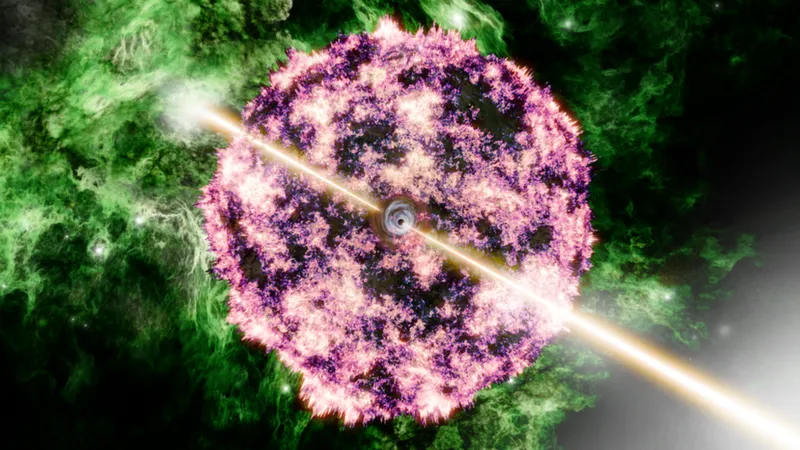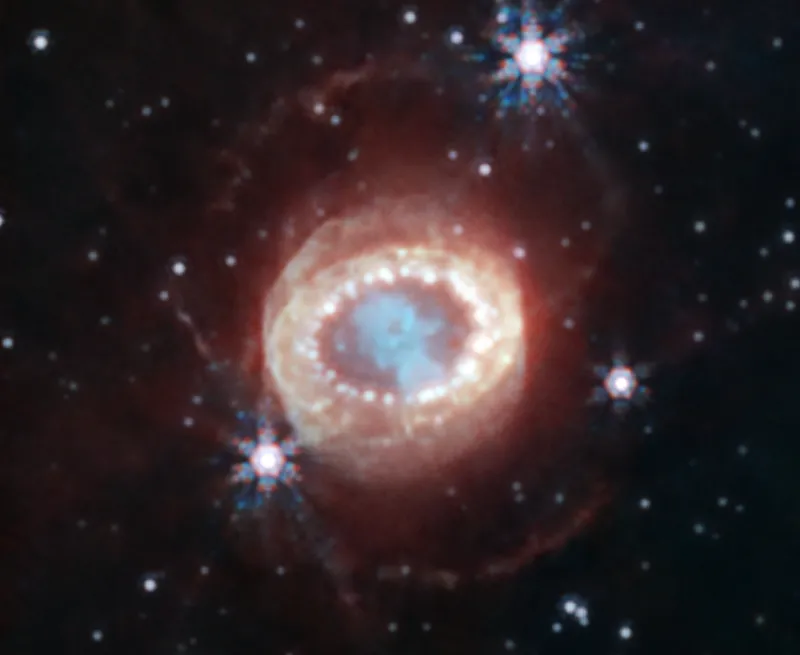Brightest-ever explosion's mystery of missing gold
 Scientists have recently unraveled the origins of the most dazzling burst of light ever observed. This luminous phenomenon, detected in 2022, was found to originate from a stellar explosion, commonly referred to as a supernova. However, the sheer brilliance of this burst surpassed what would typically be expected from such an event alone.
Scientists have recently unraveled the origins of the most dazzling burst of light ever observed. This luminous phenomenon, detected in 2022, was found to originate from a stellar explosion, commonly referred to as a supernova. However, the sheer brilliance of this burst surpassed what would typically be expected from such an event alone.
This discovery has led researchers to confront two perplexing mysteries. Firstly, the extraordinary luminosity of the burst challenges existing explanations, raising questions about additional factors contributing to its intensity. Secondly, and perhaps even more profoundly, it casts doubt on the prevailing understanding of how heavy elements, like gold and platinum, are formed in the universe.
According to current scientific understanding, supernovas are believed to be the primary source of heavy elements in the cosmos. However, the discrepancy between the observed brightness of this burst and conventional supernova models suggests that there may be unknown mechanisms at play in the creation of heavy elements. This revelation prompts a reevaluation of our comprehension of cosmic chemistry and the processes responsible for generating the elements that compose our world.
In essence, while the discovery sheds light on one cosmic mystery, it simultaneously deepens the enigma surrounding the origins of heavy elements, challenging scientists to delve deeper into the fundamental mechanisms driving the evolution of the universe.
The absence of heavy elements in the recent discovery challenges our understanding of how precious metals like gold are formed, prompting fresh inquiries into their origins. Professor Catherine Heymans from the University of Edinburgh and Scotland's Astronomer Royal, who is not directly affiliated with the research team, emphasized the significance of such findings in advancing scientific knowledge.
She highlighted the inherent wonder of the universe, noting that its mysteries continuously inspire exploration and innovation. Heymans expressed enthusiasm for the unexpected twists and turns encountered in scientific discovery, emphasizing that these challenges prompt researchers to revisit their assumptions, refine theories, and ultimately develop more robust explanations for the complexities of the cosmos.
Unprecedented Gamma Ray Burst Mystifies Astronomers
 In October 2022, telescopes detected an explosion originating from a distant galaxy 2.4 billion light-years away. This event emitted light across all frequencies, with a notable intensity in gamma rays, a highly penetrating form of X-rays.
In October 2022, telescopes detected an explosion originating from a distant galaxy 2.4 billion light-years away. This event emitted light across all frequencies, with a notable intensity in gamma rays, a highly penetrating form of X-rays.
Lasting seven minutes, the gamma ray burst was so exceptionally powerful that it exceeded the detection capabilities of instruments, registering as 100 times brighter than any previously recorded event. Dubbed the Brightest Of All Time (B.O.A.T.) by astronomers, its magnitude surpassed conventional explanations associated with supernova explosions.
Despite being initially overwhelming, the gamma ray burst allowed for observations by NASA's James Webb Space Telescope (JWST), a stroke of fortune given the telescope's recent operational readiness. These rare, potent explosions are estimated to occur only once every 10,000 years, providing a unique opportunity for astronomers to investigate.
As the luminosity diminished, JWST's instruments revealed evidence of a supernova explosion, albeit not as immense as anticipated. This discrepancy between the expected supernova magnitude and the unprecedented gamma ray burst intensity poses a perplexing question: What caused the burst to reach such extraordinary levels of brightness? Dr. Peter Blanchard, co-leader of the research team, is determined to unravel the mystery behind the unprecedented gamma ray burst. His plan involves securing additional observation time on the JWST to investigate other remnants of supernovas, hoping to shed light on the phenomenon.
Dr. Peter Blanchard, co-leader of the research team, is determined to unravel the mystery behind the unprecedented gamma ray burst. His plan involves securing additional observation time on the JWST to investigate other remnants of supernovas, hoping to shed light on the phenomenon.
Expressing uncertainty about the direct link between gamma ray bursts and supernova explosions, Dr. Blanchard suggests that they might be distinct processes occurring independently. Meanwhile, Dr. Tanmoy Laskar, co-leader of the study from the University of Utah, proposes a potential explanation for the remarkable brightness of the B.O.A.T.
According to Dr. Laskar, the intensity of the burst may be attributed to the way in which narrow jets of material are ejected during supernova events. These jets, when narrow, concentrate the emitted light into a more focused beam, akin to focusing a flashlight's beam into a narrow column rather than a broad one. In this case, the gamma ray burst exhibited one of the narrowest jets observed so far, offering insight into why its afterglow appeared exceptionally bright.



































